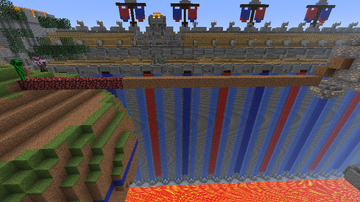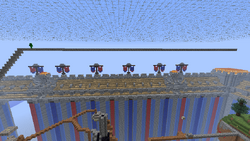
A simple netherrack/dirt bridge constructed to reach the first node quickly.
Bridges are the primary means of traversing the battlefield and the stage for most of the game's action. Bridge-building (or bridging) is one of the central mechanics of OO:SoS and a skill integral to any team's victory.
Construction Materials[]
- Dirt: The most accessible and naturally abundant bridging material. Dirt is the choice material for quickly bridging to nodes since it can be harvested rapidly without any tools or setup. Because it is so easily destroyed, however, it is not recommended for use in lasting offensive bridges. Extensive dirt production must be undertaken with care as careless digging can produce blindspots on the planet and allow invaders easier access to the core.
- Cobblestone: Cobblestone boasts the highest durability of the primary materials, requiring either a pickaxe or great patience to destroy effectively. This makes it the preferred material for offensive bridges, helped somewhat by the fact that it yields nothing when broken by hand. Its resilience is counterbalanced by its high cost; cobblestone is collected slower than dirt or wood, and since it is also highly demanded for fortifying the planet and crafting weapons/tools, the amount available for bridging is often limited.
- Wood: Wood planks are seldomly used exclusively for bridges and usually appear on the battlefield only when both dirt and cobblestone are in short supply. Wood boasts better durability than dirt and can be produced nearly as quickly, but is harmed somewhat by its flammability and the fact that it produces blocks when broken by hand. Moreover, the amount of wood that can be rapidly produced is limited by the team's supply of bonemeal - most of which is turned into sticks for crafting.
- Slabs: Slab bridges are initially appealing as they are more durable than wood bridges, require half the resources, and are naturally protected against mob spawning. However, great care must be exercised when laying down slabs, as placing one on top of a slab on which you are standing can cause you to fall through. This risk factor deters many players from using slabs for this purpose. It is also advisable that you keep in mind that all it takes is a single block to one way someone on a bridge, as the block you place on top will appear to float, counting the slab below it as a full block.
Note that cobblestone slabs may also be used, but wood is the preferred source material as it is cheaper and equally effective.No longer true as of 1.3.1
Types of Bridges[]
Center Bridge[]

Also referred to as a middle bridge, these are bridges that are constructed directly off the planet. These are used initially when trying to obtain the nodes, but are often the first battleground when one team connects their own bridge to their enemy's.
Low Bridge[]
Also called a low bridge. These are bridges that are usually built off of the qol or secondary nodes. If one wants to make a low bridge they should do so off the second node, as the blocks inside of the node will aid you in quickly crossing the map. Keep in mind that the only reason to make or use a low bridge is to hope to go by unnoticed, as the enemy will always have the height advantage over you. It is advisable to bring pearls so that you can compound the stealth factor, letting the enemy think that you have not yet finished the bridge if they do spot it. When preparing to enter the enemy's planet, one should make sure that they have a pickaxe, food, and a sword, as it is almost guaranteed to be a one-time deal. When dealing with low bridges, be sure to dismatle the bridge back to its source, even going as far as breaking down the node itself so that the enemy can no longer bridge at that level.
Sky Bridge[]

These are bridges that span over the rest of the arena. They can either be built from the top of a tower (with ladders for accessibility) or a staircase. Stairs and ladders, however, often prove to be a downfall of the sky bridge. It is very easy to stop progress up them while still allowing teammates to descend them by placing blocks in the way of stairs, or by breaking the top few ladders. Still, the height advantage provided by the sky bridge causes most of the late game to be based on gaining or keeping control of the sky.
Half Slope[]
One Slope[]
Defending Bridges[]
One of the most dangerous aspects of OO: SOS is that if not defended properly, your own bridge can be overtaken by your opponents, and will end up serving as a direct line to your home planet. Many games are decided by who gains control of the main bridge or bridge system and succeeds in placing a forward bed, so knowing strategies for defending your bridges is very important!
- Location: Remember to keep in mind the height you are aiming for and the amount of start-up space required to reach that height. Starting from the home planet with a skybridge is probably the most common and best option for a team, as it allows them to quickly ascend the staircase to fend incoming attackers off of it. The closer the apex of the skybridge to your spawn point the better, which is why many forward bases are made at the top of a staircase.
- Height Advantage: When building to intercept an opposing bridge, it is always beneficial to build at a higher level than their bridge is at. This is simple measure ensures that at the time contact is initiated, the bridge is already one-way to allow only friendly team members past.
- One-waying : One waying is a technique in which a staircase of only a couple blocks is constructed on top of a bridge, so that team members from one side may pass with ease but their opponents must construct their own stairs to pass through. One waying is not effective as a long-term solution to defending a contested bridge, however, only serving to slow the progress of the opposing team.
- Iron Doors: Simple but effective in restricting access to a forward base, Iron Doors are practically impossible to get through if there is a bed on the other side of them. However, building around or over them can prove relatively easy if opponents rush from the outside.